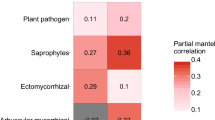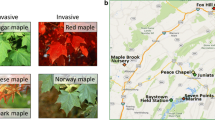Abstract
Fungal communities in soil have significant influences on terrestrial ecosystem dynamics, yet our understanding of the drivers of fungal diversity and community structure in soil is limited. Fungal communities associated with the rhizosphere of four native perennial grassland plant species, two legumes and two grasses, grown in monoculture and polyculture in a long-term field experiment were characterized. Reference databases were developed for, and amplicon libraries sequenced from, multiple-copy rRNA and single-copy protein-coding loci. Clustering and alignment-based pipelines were utilized to evaluate differences in fungal community structure and diversity in response to plant host, plant community richness, and soil edaphics. Fungal diversity increased in the rhizosphere of plants growing in polyculture plant communities as compared to monoculture plant communities. Fungal community structure was differentiated between legumes and grasses growing in monoculture but not in polyculture. To specifically monitor fungi in the genus Fusarium in the soil, the protein-coding locus was used to increase phylogenetic resolution and enrich for this taxon. These data show that fungal community richness and structure are strongly linked with plant community dynamics and associated soil edaphic characteristics in these grassland soils.



Similar content being viewed by others
References
Blackwell M (2011) The Fungi: 1, 2, 3…5.1 million species? Am J Bot 98:426–438
Hawksworth DL (2001) The magnitude of fungal diversity: the 1.5 million species estimate revisited. Mycol Res 105:1422–1432
Schoch CL, Sung GH, López-Giráldez F et al (2009) The Ascomycota tree of life: a phylum-wide phylogeny clarifies the origin and evolution of fundamental reproductive and ecological traits. Syst Biol 58:224–239
Blackwell M, Hibbett DS, Taylor JW, Spatafora JW (2006) Research coordination networks: a phylogeny for kingdom Fungi (Deep Hypha). Mycologia 98:829–837
James TY, Kauff F, Schoch CL et al (2006) Reconstructing the early evolution of fungi using a six-gene phylogeny. Nature 443:818–822
Lutzoni F, Kauff F, Cox CJ et al (2004) Assembling the fungal tree of life: progress, classification, and evolution of subcellular traits. Am J Bot 91:1446–1480
Jumpponen A (2011) Analysis of ribosomal RNA indicates seasonal fungal community dynamics in Andropogon gerardii roots. Mycorrhiza 21:453–464
Jumpponen A, Jones KL, Blair J (2010) Vertical distribution of fungal communities in tallgrass prairie soil. Mycologia 102:1027–1041
Horwath W (2007) Carbon cycling and formation of soil organic matter. In: Eldor P (ed) Soil microbiology, ecology, and biochemistry, 3rd edn. Academic, USA, pp 303–339
Amend AS, Seifert KA, Samson R, Bruns TD (2010) Indoor fungal composition is geographically patterned and more diverse in temperate zones than in the tropics. Proc Natl Acad Sci U S A 107:13748–13753
Dumbrell AJ, Ashton PD, Aziz N, Feng G, Nelson M, Dytham C, Fitter AH, Helgason T (2011) Distinct seasonal assemblages of arbuscular mycorrhizal fungi revealed by massively parallel pyrosequencing. New Phytol 190:794–804
Jumpponen A, Jones KL (2010) Seasonally dynamic fungal communities in the Quercus macrocarpa phyllosphere differ between urban and nonurban environments. New Phytol 186:496–513
Porter TM, Schadt CW, Rizvi L, Martin AP, Schmidt SK, Scott-Denton L, Vilgalys R, Moncalvo JM (2008) Widespread occurrence and phylogenetic placement of a soil clone group adds a prominent new branch to the fungal tree of life. Mol Phylogenet Evol 46:635–644
Schadt CW, Martin AP, Lipson DA, Schmidt SK (2003) Seasonal dynamics of previously unknown fungal lineages in tundra soils. Science 301:1359–1361
Rosling A, Cox F, Cruz-Martinez K, Ihrmark K, Grelet G-A, Lindahl BD, Menkis A, James TY (2011) Archaeorhizomycetes: unearthing an ancient class of ubiquitous soil fungi. Science 333:876–879
Nilsson RH, Ryberg M, Kristiansson E, Abarenkov K, Larsson K-H, Kõljalg U (2006) Taxonomic reliability of DNA sequences in public sequence databases: a fungal perspective. PLoS One 1:e59
Buée M, Reich M, Murat C, Morin E, Nilsson RH, Uroz S, Martin F (2009) 454 pyrosequencing analyses of forest soils reveal an unexpectedly high fungal diversity. New Phytol 184:449–456
Bridge PD, Roberts PJ, Spooner BM, Panchal G (2003) On the unreliability of published DNA sequences. New Phytol 160:43–48
Goswami RS, Kistler HC (2004) Heading for disaster: Fusarium graminearum on cereal crops. Mol Plant Pathol 5:515–525
Michielse CB, Rep M (2009) Pathogen profile update: Fusarium oxysporum. Mol Plant Pathol 10:311–324
Murase J, Shibata M, Lee CG, Watanabe T, Asakawa S, Kimura M (2012) Incorporation of plant residue-derived carbon into the microeukaryotic community in a rice field soil revealed by DNA stable-isotope probing. FEMS Microbiol Ecol 79:371–379
Rodriguez A, Perestelo F, Carnicero A, Regalado V, Perez R, De la Fuente G, Falcon MA (1996) Degradation of natural lignins and lignocellulosic substrates by soil-inhabiting Fungi Imperfecti. FEMS Microbiol Ecol 21:213–219
Herrera ML, Vallor AC, Gelfond JA, Patterson TF, Wickes BL (2009) Strain-dependent variation in 18S ribosomal DNA copy numbers in Aspergillus fumigatus. J Clin Microbiol 47:1325–1332
O’Donnell K, Sutton DA, Fothergill A, McCarthy D, Rinaldi MG, Brandt ME, Zhang N, Geiser DM (2008) Molecular phylogenetic diversity, multilocus haplotype nomenclature, and in vitro antifungal resistance within the Fusarium solani species complex. J Clin Microbiol 46:2477–2490
Arenz BE, Blanchette RA (2011) Distribution and abundance of soil fungi in Antarctica at sites on the Peninsula, Ross Sea region and McMurdo Dry Valleys. Soil Biol Biochem 43:308–315
Tilman D, Knops J, Wedin D, Reich P, Ritchie M, Sieman E (1997) The influence of functional diversity and composition on ecosystem processes. Sci 277:1300–1302
Bakker MG, Tu ZJ, Bradeen JM, Kinkel LL (2012) Implications of pyrosequencing error correction for biological data interpretation. PLoS One 7:e44357
O’Donnell K, Sarver BA, Brandt M et al (2007) Phylogenetic diversity and microsphere array-based genotyping of human pathogenic fusaria, including isolates from the multistate contact lens-associated U.S. keratitis outbreaks of 2005 and 2006. J Clin Microbiol 45:2235–2248
Schloss PD, Westcott SL, Ryabin T et al (2009) Introducing mothur: open-source, platform-independent, community-supported software for describing and comparing microbial communities. Appl Environ Microbiol 75:7537–7541
Schloss PD, Gevers D, Westcott SL (2011) Reducing the effects of PCR amplification and sequencing artifacts on 16S rRNA-based studies. PLoS One 6(12):e27310
Quince C, Lanzén A, Curtis TP, Davenport RJ, Hall N, Head IM, Read LF, Sloan WT (2009) Accurate determination of microbial diversity from 454 pyrosequencing data. Nat Methods 6:639–641
Edgar RC (2004) MUSCLE: multiple sequence alignment with high accuracy and high throughput. Nucleic Acids Res 32:1792–1797
Stajich JE, Block D, Boulez K et al (2002) The BioPerl toolkit: Perl modules for the life sciences. Genome Res 12:1611–1618
Dick JM (2008) Calculation of the relative metastabilities of proteins using the CHNOSZ software package. Geochem T 9:10
Altschul SF, Madden TL, Schäffer AA, Zhang J, Zhang Z, Miller W, Lipman DJ (1997) Gapped BLAST and PSI-BLAST: a new generation of protein database search programs. Nucleic Acids Res 25:3389–3402
R Development Core Team (2011) R: a language and environment for statistical computing. R Foundation for Statistical Computing, Vienna. http://www.R-project.org/
Wickham H (2009) ggplot2: elegant graphics for data analysis. Springer, New York
Oksanen J, Blanchet G, Kindt R, Legendre P, Minchin PR, O’Hara RB, Simpson GL, Solymos P, Stevens MHH, Wagner H (2011) Vegan: community ecology package. R package version 2.0–2.http://CRAN.R-project.org/package=vegan
Anderson MJ (2001) A new method for non-parametric multivariate analysis of variance. Austral Ecol 26:32–46
Peay KG, Baraloto C, Fine PVA (2013) Strong coupling of plant and fungal community structure across western Amazonian rainforests. ISME J 7:1852–1861
Waldrop MP, Zak DR, Blackwood CB, Curtis CD, Tilman D (2006) Resource availability controls fungal diversity across a plant diversity gradient. Ecol Lett 9:1127–1135
McGuire KL, Fierer N, Bateman C, Treseder KK, Turner BL (2012) Fungal community composition in neotropical rain forests: the influence of tree diversity and precipitation. Microb Ecol 63:804–812
Bakker MG, Bradeen JM, Kinkel LL (2013) Effects of plant host species and plant community richness on streptomycete community structure. FEMS Microbiol Ecol 83:596–606
Rousk J, Bååth E, Brookes PC, Lauber CL, Lozupone C, Caporaso JG, Knight R, Fierer N (2010) Soil bacterial and fungal communities across a pH gradient in an arable soil. ISME J 4:1340–1351
Scherling C, Roscher C, Giavalisco P, Schulze E-D, Weckwerth W (2010) Metabolomics unravel contrasting effects of biodiversity on the performance of individual plant species. PLoS One 5:e12569
Balmas V, Migheli Q, Scherm B, Garau P, O’Donnell K, Ceccherelli G, Kang S, Geiser DM (2010) Multilocus phylogenetics show high levels of endemic fusaria inhabiting Sardinian soils (Tyrrhenian Islands). Mycologia 102:803–812
Harrow SA, Farrokhi-Nejad R, Pitman AR, Scott IAW, Bentley A, Hide C, Cromey MG (2010) Characterization of New Zealand Fusarium populations using a polyphasic approach differentiates the F. avenaceum/F. acuminatum/F. tricinctum species complex in cereal and grassland systems. Fungal Biol 114:293–311
Amend AS, Seifert KA, Bruns TD (2010) Quantifying microbial communities with 454 pyrosequencing: does read abundance count? Mol Ecol 19:5555–5565
Kunin V, Engelbrektson A, Ochman H, Hugenholtz P (2009) Wrinkles in the rare biosphere: pyrosequencing errors can lead to artificial inflation of diversity estimates. Environ Microbiol 12:118–123
O’Donnell K, Rooney AP, Proctor RH et al (2013) Phylogenetic analyses of RPB1 and RPB2 support a middle Cretaceous origin for a clade comprising all agriculturally and medically important fusaria. Fungal Genet Biol 52:20–31
Acknowledgments
We thank Joey Spatafora, Frank Kauff, François Lutzoni, and David Geiser for supplying a subset of the sequences used as references in this study, Georgiana May for supplying 454 compatible LSU primers, Chris Wright at the Roy J. Carver Sequencing Center, Dave Tilman at the Cedar Creek Ecosystem Science Reserve LTER, as well as Matt Bakker, Dan Schlatter, and Lindsey Otto-Hanson for their contributions to soil sampling and processing. We also acknowledge the comments from anonymous reviewers which helped improve the quality and clarity of this manuscript. This project was supported by Agriculture and Food Research Initiative Competitive Grant no. 2011-67019-30200 from the USDA National Institute of Food and Agriculture.
Author information
Authors and Affiliations
Corresponding author
Rights and permissions
About this article
Cite this article
LeBlanc, N., Kinkel, L.L. & Kistler, H.C. Soil Fungal Communities Respond to Grassland Plant Community Richness and Soil Edaphics. Microb Ecol 70, 188–195 (2015). https://doi.org/10.1007/s00248-014-0531-1
Received:
Accepted:
Published:
Issue Date:
DOI: https://doi.org/10.1007/s00248-014-0531-1




